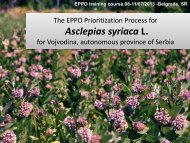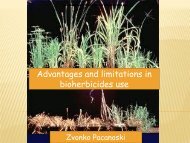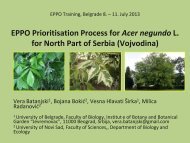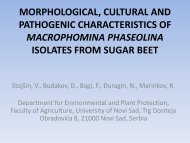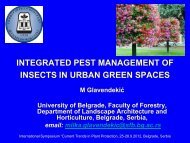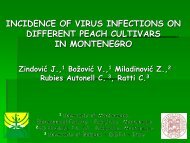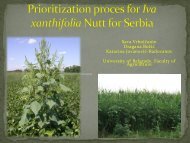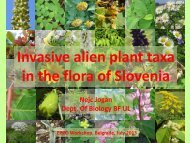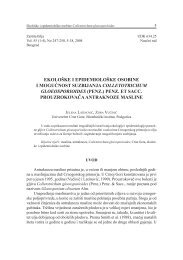(HEMIPTERA: PSYLLOIDEA) IN SERBIA Dušanka Jerinić ... - Izbis
(HEMIPTERA: PSYLLOIDEA) IN SERBIA Dušanka Jerinić ... - Izbis
(HEMIPTERA: PSYLLOIDEA) IN SERBIA Dušanka Jerinić ... - Izbis
Create successful ePaper yourself
Turn your PDF publications into a flip-book with our unique Google optimized e-Paper software.
ALIEN SPECIES OF JUMP<strong>IN</strong>G PLANT LICE<br />
(<strong>HEMIPTERA</strong>: <strong>PSYLLOIDEA</strong>) <strong>IN</strong> <strong>SERBIA</strong><br />
<strong>Dušanka</strong> <strong>Jerinić</strong>-Prodanović<br />
University of Belgrade, Faculty of Agriculture,<br />
Nemanjina 6, 11080 Zemun, Serbia<br />
E-mail: dusanka@agrif.bg.ac.rs
- Psyllids or jumping plant-lice are small<br />
sup-sucking insects,<br />
- 1-10 mm long.<br />
- Together with white flies, aphids and scale<br />
insects they constitute suborder<br />
Sternorrhyncha within the order Hemiptera.<br />
- usually develop on woody dicotyledons<br />
(Burckhardt, 1994), except for several<br />
species from genus Livia, developing on<br />
monocotyledons.<br />
- Most species have very restricted host<br />
plant ranges.<br />
- More than three-quarters of psylloid<br />
species are free-living in larval stages,<br />
while other develop in open or closed galls.<br />
- Australian species from subfamilies<br />
Spondyliaspidinae, Pachypsyllinae and<br />
Macrocorsinae build waxy coverings,<br />
called lerps.
- Damage on plants can be induced<br />
directly by sap-sucking, or by the<br />
excretion of honey-dew while<br />
feeding, which is suitable for sooty<br />
mold development.<br />
-Several species of jumping plantlice<br />
are vectors of bacterial or viral<br />
pathogens, such as phytoplasma in<br />
the first place,<br />
- they pose a potential danger for<br />
cultivated plants.<br />
honey-dew<br />
Sooty mold<br />
Liberibacter americanus<br />
(S. Amerika)<br />
Pear decline phytoplasma
- Small body size and unobtrusive colour<br />
enables them to be transferred over<br />
longer dinstances by wind or with host<br />
plant.<br />
-There have been 3850 species of<br />
jumping plant-lice described in the world<br />
(Malenovsky, et. al., 2012).<br />
- In Europe there have been registered<br />
282 species.<br />
-14 have been determined as invasive.<br />
From family Psyllidae, 11 species have<br />
been determined, and from family<br />
Triozidae three species (Mifsud, et. al.<br />
2010).
- Calophya rhois is a<br />
Mediterranean species introduced<br />
into Central Europe, the Great<br />
Britain and China.<br />
- develops on Cotinus coggygria<br />
Scop.<br />
- larvae cause curling and bending<br />
of leaves inwards, developing a<br />
kind of a gall.<br />
Calophia rhois (Löw 1877)<br />
Cotinus coggygria
- larvae also feed on branches,<br />
excreting a large amount of<br />
honeydew, suitable for the<br />
development of sooty mold.<br />
-overwinters in adult stage on other<br />
plants, most probably conifers.<br />
- has two generations per year.<br />
Calophia rhois (Löw 1877)
Calophia rhois (Löw 1877)
Homotoma ficus (Linnaeus, 1758)<br />
H. ficus is native to Central-Southern<br />
Europe and the Middle East, feeding<br />
on Ficus carica L.<br />
It has been introduced together with<br />
the host plant into other countries<br />
outside the original distributional<br />
range, too.<br />
H. ficus present in Great Britain,<br />
Switzerland, coastal regions of<br />
Slovenia, Croatia, Montenegro,<br />
Bulgaria.<br />
It is alien to North America (Hollis and<br />
Broomfield, 1989).<br />
In Serbia, Homotoma ficus was<br />
registered for the first time on fig<br />
(Ficus carica) in Belgrade area in<br />
2008.
Homotoma ficus (Linnaeus, 1758)<br />
-has one generation<br />
per year.<br />
- overwinters in the<br />
egg stage on the<br />
host plant.<br />
- Larvae of H. ficus<br />
started hatching on<br />
March.<br />
-While feeding,<br />
larvae excrete<br />
honeydew which is<br />
usually wrapped in<br />
wax.<br />
- their presence can be recognized by wax<br />
secretion in the form of drops or threads on<br />
leaves.<br />
- Eclosion of adults was registered at the<br />
end of May.
Homotoma ficus (Linnaeus, 1758)<br />
-first instar with yellow body. -<br />
egg is oval in shape, with<br />
pedicel situated ventrally and<br />
long terminal filament.<br />
- recently laid eggs light<br />
yellow, later becoming bright<br />
yellow.
Homotoma ficus (Linnaeus, 1758)<br />
Fifth-instar bright green with whitish wing<br />
pads, dorsum and body margin densely<br />
covered with simple setae.<br />
The fig psylla has one generation<br />
per year. Overwinters in the egg<br />
stage on the host plant.
Acizzia jamatonica (Kuwayama, 1908)<br />
A. jamatonica is an East-Asian<br />
species, until 1980 known only in<br />
Japan. It was then registered in<br />
South Korea in 1983, in Taiwan in<br />
1984, and in China in 1992 (Lauterer<br />
et al. 2011). In 2001 it was registered<br />
for the first time in Europe, in the<br />
North of Italy. After this record, it was<br />
registered in other European<br />
countries as well (France, Slovenia,<br />
Switzerland, Hungary, Bulgaria,<br />
Serbia, Greece, Slovakia) (Seljak,<br />
2006., Šimala et al., 2006., Vétek<br />
Redei, 2009., Vétek et al., 2009,<br />
Mifsud et al., 2010). Since 2006, its<br />
presence has also been registered in<br />
Southeast part of the USA (Mifsud et<br />
al., 2010).<br />
Albizzia julibrissin
Acizzia jamatonica (Kuwayama, 1908)<br />
Young adults are light green<br />
Overwintering adults are brown
Acizzia jamatonica (Kuwayama, 1908)<br />
Eggs elongated, dark yellow to orange, with a tail-like appendage at one end, and<br />
at the other a stinger inserted into leaf tissue.
Acizzia jamatonica (Kuwayama, 1908)<br />
- larvae (L1) are light yellow, almost<br />
transparent.<br />
- the larvae of the final stage (L5) are<br />
light green with light brown antennae,<br />
rudiments of wings and legs. The<br />
apices of antennae and legs dark<br />
brown, eyes pink
The damage on plants<br />
is caused by larvae<br />
and adult specimens<br />
sap-sucking on leaves,<br />
flowers and young<br />
legumes.<br />
Stronger infestation<br />
leads to yellowing and<br />
premature leaf falling.<br />
They also cause<br />
secondary damages<br />
on infested plants,<br />
manifested as<br />
honeydew excretion<br />
and appearance of<br />
sooty mold on the<br />
excreted honeydew.<br />
Acizzia jamatonica (Kuwayama, 1908)
Acizzia jamatonica (Kuwayama, 1908)<br />
Larvae excrete large amounts of wax secretions, which altogether reduces<br />
decorative value of infested trees.
Acizzia jamatonica (Kuwayama, 1908)<br />
- In our conditions, A. jamatonica overwinters in adult stage outside the host<br />
plant<br />
- It has more than two generations per year.<br />
- In Croatian sea coast and Slovakia has at least four overlapping generations<br />
(Šimala et al., 2006., Lauterer et al., 2011)
Acizzia jamatonica (Kuwayama, 1908)
C. pulchella is probably a<br />
Mediterranean species.<br />
It has been registered in Western<br />
Mediterranean (Italy, France, Greece)<br />
and Asia Minor, from where it has<br />
been introduced into other countries,<br />
such as: the Great Britain,<br />
Switzerland, Austria, Ukraine,<br />
Slovenia, Hungary.<br />
Cacopsylla pulchella (Löw, 1877)<br />
Judas tree Cercis siliquastrum<br />
It is a monophagous species, feeding on<br />
Judas tree Cercis siliquastrum In Serbia,<br />
Cacopsylla pulchella was deterimined for<br />
the first time on Judas tree (C.<br />
siliquastrum) in Belgrade area in 2010.
Cacopsylla pulchella (Löw, 1877)
Cacopsylla pulchella (Löw, 1877)<br />
C. pulchella’s feeding and<br />
honeydew secretion are harmful.<br />
The attacked leaves become<br />
yellow and then necrotize.<br />
Besides honeydew, larvae also<br />
excrete wax secret in the form of<br />
fibres.<br />
It has one generation per year in<br />
Serbia, overwinters adult on other<br />
plants.
Trioza neglecta Loginova, 1978<br />
Elaeagnus angustifolia<br />
Trioza neglecta is originally from Southeast and Central Asia, it was introduced into<br />
Europe (Loginova, 1978). Today it is distributed in Georgia, Armenia, Azerbaijan and<br />
Iran, expanding accross Russia, Ukraine, Moldova, Bulgaria, Romania and parts of<br />
former Yugoslavia, together with host plant Elaeagnus angustifolia L., into the<br />
countries of Central Europe (Slovakia, the Czech Republic, Austria) (Lauterer and<br />
Malenovsky, 2002).<br />
The adults of T. neglecta are light green.
Trioza neglecta Loginova, 1978<br />
First-instar yellow, with colour changing to<br />
green-blue with silver reflection in the last<br />
stage of development.<br />
In our conditions, T. neglecta has two<br />
generations per year.<br />
The first generation is the least numerous<br />
and its adults appear in June and July,<br />
while the second generation is a little more<br />
numerous. Larvae can be found<br />
throughout September until the middle of<br />
November.
Thank you for attention!






